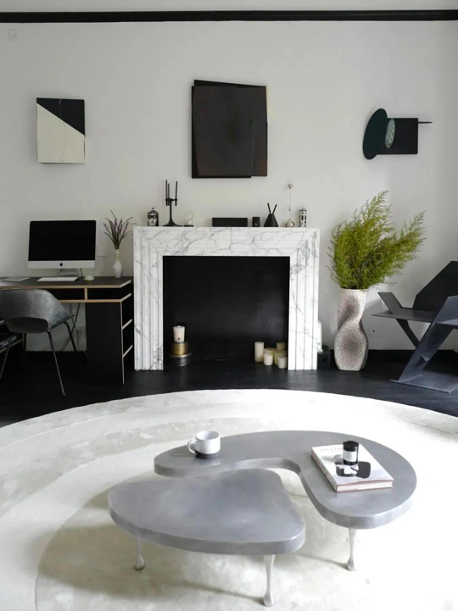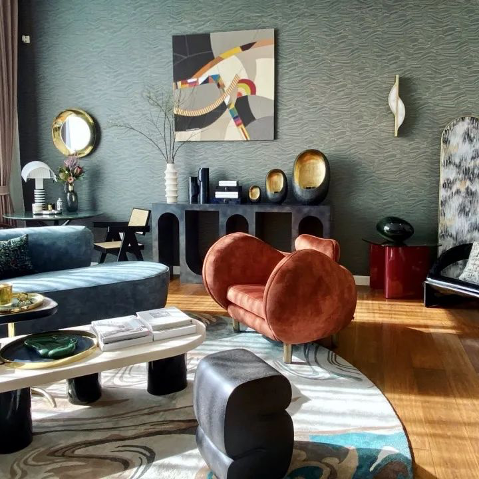From 0 to 1: Starting your art collecting journey
Get an insight into starting your art collection from two experts in the field ahead of Affordable Art Fair Shanghai on 8 – 11 June 2023.

Art collecting is a personalised journey.
We hope that through this special feature we will answer the question: “How to go from zero to one in an art collection?” And “how have people gone from art lovers to novice collectors?”
We invited representatives from inside and outside the art world to talk about their first collecting experiences. Through their multi-dimensional perspective and advice, it opens the door to collection for people who love art but continue to wonder.
We invited art collector Jason (Huang Jingsheng), general manager of the Thousand Trees Project, and Anya Yan, interior designer and art collector, to talk about their first art collection.
Jason (Huang Jingsheng)

What was the first work in the Thousand Trees Collection? When did you start your collecting journey?
Jason: The first work in the collection is a sculpture by American artist Daniel Arsham, “The Grey Plaster Statue of Venus Eroding Arles”, which is now on display in the Thousand Trees Commercial Center.
The opportunity to start collecting began because I have loved art since I was a child. In the past, it was mainly about exhibitions, but when I began to run and manage an entire commercial center like Qianshu, designed by the famous architect Thomas Heatherwick, I would think about how it should be improved and enriched to match the external uniqueness of the building.
Because we have always emphasised Senki’s Slogan “Enjoy the difference”, we wanted to do art-related content in a building that resembles a work of art. Since then, I have been connecting with many galleries and various art spaces and institutions, exploring the possibility of combining art collection and commercial bodies. The series of works by Daniel Arsham presented in our opening exhibition, “Contemporary Revival” officially started the Thousand Trees’ collection.

Can you sum up the experience of your first collection in three words?
Jason: I think the first one is accomplishment. This is not to say that when we buy a piece of art, it becomes an accomplishment. For me, the true achievement lies in sharing these artworks with others and creating an environment where people can enjoy them. We provide opportunities for others to experience aesthetic and cognitive satisfaction through their daily consumption and leisure activities. This is the main source of my sense of achievement.
The second word is freshness. After all, it was the first time I collected a work of art and presented it in a commercial space, which still excites me.
The last word is sense of mission. Because I believe that art and life should be better combined. From “freshness” to “accomplishment” to “mission” – these three words are what we aim to do more of in the future. We want more people to see works of art in the open space, and enjoy them without threshold. The public can perceive art in the corners of life, which is something that I think is very necessary. We also want to bring art into everyone’s lives.
Which art genre are you focusing on right now?
Jason: We don’t really limit the types of artworks in our collections. I visit lots of art exhibitions and galleries to admire many different mediums of artworks, and refine my ability to perceive beauty through continuous learning. A work must first conform to its own aesthetic, and then it must conform to the environment in which it will be presented in the future. I pay more attention to whether a piece has an “eye”, or enough to make my eyes shine.

Has your mindset changed since you started collecting art?
Jason: One of the things I started to realise was that the work I liked didn’t have to be expensive. That is to say, it does not have to be a certain price to be attractive. I think it’s more about listening to your inner voice. There are some things that are not so valuable in the market, including photography, which I like. Art should not be divided into expensive and cheap, and the difference in the price of a work should not affect your judgement of an artist and a work. Don’t chase the wave of the market.
In your opinion, what does art collecting mean for the general public?
Jason: Taking Thousand Trees as an example, I think a lot of art collections are presented to the public in the form of exhibitions. It’s a clear-cut way to raise awareness of art among the masses and learn at the same time. Many people start with the word “beauty” and what is good and what it is that they like. Start with small works and then slowly broaden your horizons. I think China has reached a period where material needs are basically satisfied and so spiritual pursuits are being pursued. Art collecting means that our social development has reached a new level.
Any advice for people who are just about to start art collecting?
Jason: The first is to be humble and then the second is to stay true to yourself. Staying humble refers to the art industry as a whole. Loyal to yourself means to be loyal to your own aesthetics, learn what you like, and don’t follow the heat. Buy what you love, don’t “follow the flow”.
Anya Yan

What was the first piece in your collection?
Anya: My first piece was called “41 Hz-II” by Feng Chen, which I purchased in 2017. It now hangs in my living room in Beijing. When the home was renovated and I needed some paintings for the walls, a friend recommended a solo exhibition by Feng Chen at the Shanghai Capsule Gallery. I was fascinated by his interactive installation that combined sound and image, including an acrylic painting on paper that captured the movement of water and sound through a technique called “Water Topology Painting” (traditional Turkish marbling). I love how it’s like hearing the sound of the tide. It is very calming. I met many friends who were involved in the art world in Beijing, including galleries and artists like Wang Jiaja and Hou Zichao from the Spurs Gallery who are now thriving.

Which art genre do you focus on right now? Did the original collection set the aesthetic for the present?
Anya: When I began my art collection, I started with artists who were friends and peers. My collection includes a mix of installation art, paintings, and collectible furniture. As an interior designer, I am naturally drawn to works that have a strong sense of space, such as installations and sculptures by Ni Youyu and Cai Lei. I’m also passionate about abstract art and have been paying more attention to female artists recently. Although my aesthetic preferences may not be uniform across all the works in my collection, I do have a methodology for hanging and displaying them in a way that enhances their impact.
How do you choose an artwork for your interior space?
Anya: When choosing a work for an indoor space, it’s important to consider a number of factors. First of all, think about the function of the space and whether the work is suitable – such as choosing soft, quiet works for the bedroom. Secondly, consider the scale of the work and how this will impact its relationship with architecture, furniture and other accessories in the home. I consider various factors, from the materials used to the colours and even the brushstrokes of the artwork.


For different spatial styles, do you choose works where materials, media and styles collide?
Anya: I sometimes deliberately pick pieces that collide with the tone of the space. For example, at my home in Shunyi, Beijing, the living room is based on a dark green wallpaper with geometric patterns. The first artwork was a leather painting by Italian artist, Giorgio Sarporiti which is filled with colourful geometric blocks.
In order to complement and contrast the work, an orange flannel sofa was chosen, alongside a red lacquered coffee table, copper candlesticks, mirrors, and wall lamps that echoed the yellow in the canvas. The plates and vases on the coffee table and dining table were also decorated with gold accents. The carpet has a bold, colourful pattern like the Dunhuang murals. Although there are many colours, the overall combination is harmonious.

Any advice for people who are just about to start art collecting?
Anya: Art collecting requires a certain understanding of art history. I would recommend that new collectors read more about art history or maybe attend a class. Visiting art museums to see exhibitions is always helpful in understanding art better.
Affordable Art Fair Shanghai takes place at Shanghai Exhibition Centre from 8 -11 June. Visit our WeChat for tickets and more information.
